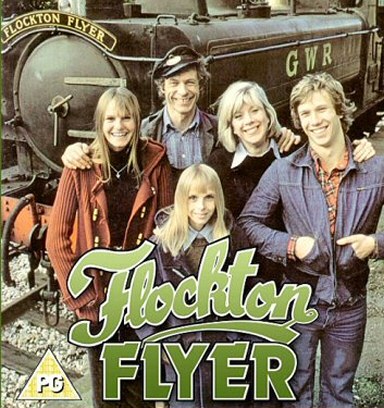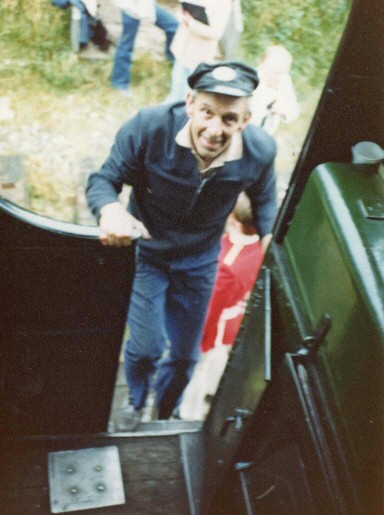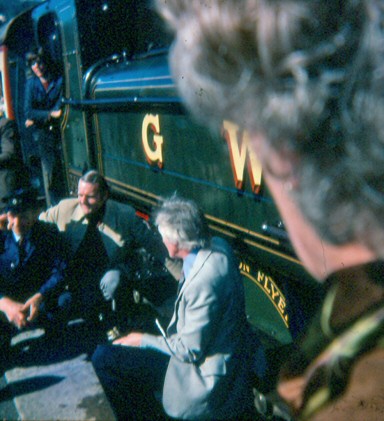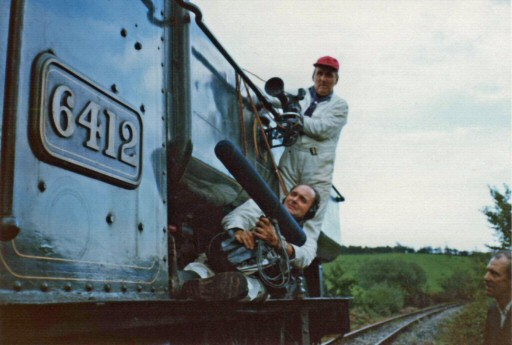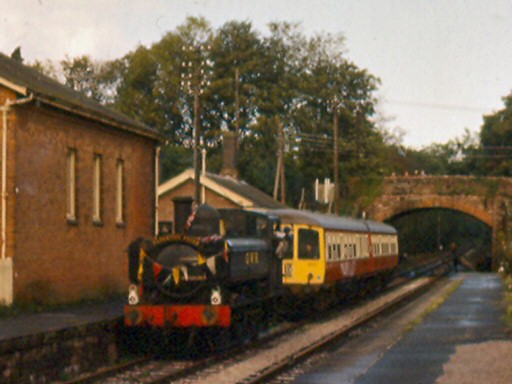"Return to Flockton" - what happened next
Return to Flockton - a feature by Nick Jones
Nick Jones concludes his comprehensive feature about the filming of the "Flockton Flyer" on location along the West Somerset Railway in 1976 and 1977.
Both series got repeat runs on ITV - series 1 from 8th September 1978, and series 2 from 14th December 1979. Southern TV lost the ITV franchise from 1st January 1981, and the rights to the programmes were sold off. In the early days of 'The Children's Channel' on cable and satellite in the 1990s, the programmes had an airing. When these broadcasts were over, the tapes were put into archive storage; the rights changed hands several times, although the programmes themselves gradually faded into obscurity and were at risk of being entirely forgotten
Fortunately, the era of home DVD and the release of TV favourites dawned, and action to rescue the Flockton Flyer from obscurity and available for viewing. The programmes show how the WSR looked back in its early days. The programmes are also a reminder of a lost era of childrens' TV programming.
As 6412 and some of the cast steamed off under Lydeard Bridge into the sunset, waved on their way by the younger members of the Carter family, we wondered if they would be back for a third series. Director Colin Nutley seemed confident that the crew would be returning. It was not to be, however. Southern TV diverted resources into their massive hit 'Worzel Gummidge' and their version of 'Enid Blyton's Famous Five'.
The two series of Flockton Flyer are now available on DVD. Produced by Simply Home Entertainment and accompanied by a 24-page production notes booklet, the two-DVD set is ready to purchase from WSR shops and several online sources. The booklet was co-written by childrens' TV historian Alistair McGown and me, and contains a considerable amount of information about the production and those involved.
I'd like to thank Keith Hawkins and John Wood for their memories and their pictures used to accompany this article. Credit is due, too, to Childrens' TV historian Alistair McGown, with whom I've worked to get the Flockton Flyer released on DVD - his contacts and experience have helped greatly in making this happen. Thanks also to Steve Edge for providing the space for this article and for his encouragement.
Trains and Children
In the years before "the family car" and package holidays, the railways played a larger part in the lives of many more people than they do today. Children lucky enough to go on holiday would probably have been taken there by train. Many would have gone to school by train, and perhaps had relations and friends who worked on the railways. So railways and trains provided a huge area of interest for children. Countless youngsters spent time on station platforms collecting engine numbers. The more adventurous would go on sorties to "bunk" around the locomotive sheds, where, depending on the attitude of the staff there, they would either be thrown out or shown around the engines.
This interest in railways amongst children found its way into literature. Perhaps the most famous being E Nesbit's "The Railway Children", first published in serial format in "The London Magazine" from January 1905. The adventures of three children, Bobbie, Peter and Phyllis Waterbury, whose family finds itself in difficult circumstances but whose lives become entwined with the local railway.
"The Railway Children" was made into a series of 8 half-hour programmes by the BBC and first broadcast early in 1951. This series contained film inserts but would have been broadcast "live" as the actors performed in the studio. The performances were repeated about a year later. In 1957 the same production, with a nearly all new cast was broadcast.
In 1968, the BBC produced another "The Railway Children" series, with Taunton-born actor Jenny Agutter as Bobbie. Jenny was cast by director Lionel Jeffries to play the same role in the famous big-screen production of "The Railway Children", which premiered in 1970.
Many youngsters have enjoyed the Revd. W. Awdry's "Thomas the Tank Engine" books and these have inspired hugely successful animated children's TV programmes, which today have become a freestanding industry.
In 1970, the BBC "Blue Peter" programme became involved with the BR Eastern Region's A2 2-6-4 locomotive of the same name, when its preservation career was launched. Over 60,000 people turned-up at York station to witness the event.
So, there is no doubt about the appeal of railways and steam locomotives to children. It is not surprising that in 1976 when looking for a children's drama to replace the long-running and successful "Freewheelers", Southern Television should look to railways and trains for inspiration. The TV station's search led them to Flockton Flyer, written by Peter Whitbread.
Why use the WSR?
The Flockton Flyer stories are about a shut-down railway being refurbished by the Carter family and other members of F.L.E.R.P.S. (the Flockton - Lane End Railway Preservation Society). Colin Nutley, the Producer, was seeking a location that would look like a disused railway. In autumn 1976 the WSR had 12 disused miles of railway. The local scenery - coast, hills, villages and farmland would all be useful in telling the story.
And the star of the show? The WSRA had purchased 6412 from the Dart Valley Railway earlier in the year and she was half of the operational locomotive fleet. Colin Nutley took one look at the 1934 vintage ex-GWR "Pannier" tank engine and knew that he'd found his "Flyer". Colin and his Production Assistant, Christine Richardson, spent a couple of days on the railway in the summer of 1976, taking scores of Polaroid pictures of the line and the scenery, planning the shots they required. Negotiations between the Railway Company and Southern TV about the facility fee were undertaken.
Organising the filming on the railway
With the line's only locomotive facilities at Minehead, 6412 had to be lit-up by 4.00 am so that she could be readied and run up the line, clear beyond Williton, before the 7.30 am DMU departure. With the restrictive signalling facilities of those days, a Train Staff transfer by road was required between Blue Anchor and Minehead after the engine had cleared the section. The section between Blue Anchor and Williton was operated by Train Staff and Ticket, which made things a little easier between those stations.
When filming had finished, the loco had to return to Minehead for disposal. This occurred after the last down DMU service had arrived at Minehead a little before 6.00 pm., and the reverse of the morning's Train Staff transfer had to be made.
Some of the filming was done at Minehead, which stood as "Flockton" in the first series. The DMU service allowed sufficient time between trains for the necessary film scenes to be set-up and shot whilst the platform was not required for passengers.
As well as engine, wagons, coaches, DMU vehicles, the WSR also had to provide traincrew. The railway's Locomotive Superintendent, Harry Lee, became the chief point of contact between the film crew and the railway. Harry was driver in charge of 6412 and was responsible for delivering what the Producer wanted. With Harry on the footplate were either Keith Hawkins, whose maritime employment allowed significant spells of shore-leave, or John Wood, a long-term WSR volunteer and committee member who was one of the WSR's earliest firemen. Harry, Keith and John all appear in the programmes, as do several other folks who were often seen on the railway in those days.
The Regular Cast
Playing members of the Carter family, who are at the centre of the Flockton Flyer stories are:
| Bob | David Neal |
| Kathy | Sheila Fearn |
| Jimmy | Peter Duncan |
| Jan | Gwyneth Strong |
| Jessica | Annabelle Lanyon (Series 1) Catrin Strong (Series 2) |
Other regularly appearing characters are:
| Commander Frost | Anthony Sharp |
| Bill Jelly | Geoffrey Russell |
| Althea Frost | Margaret Wedlake |
Return to Flockton
A feature by Nick Jones
Page 4 of 4
- 1 Introduction
- 2 Episodes from Series One
- 3 Episodes from Series Two
- 4 What happened next
Gallery
The filming of the TV series "Flockton Flyer"

